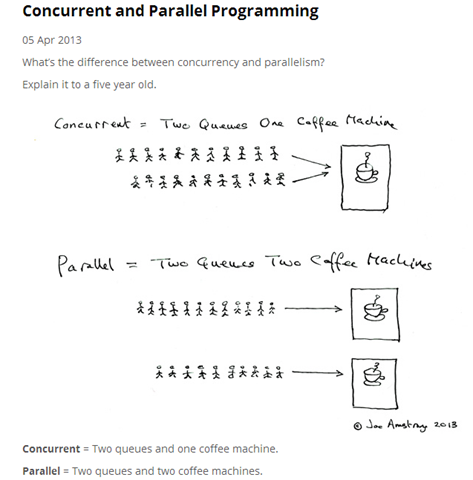线程状态
在Thread.State 中关于线程状态的解释
-
NEW
Thread state for a thread which has not yet started.
-
RUNNABLE
Thread state for a runnable thread.
A thread in the runnable state is executing in the Java virtual machine but it may be waiting for other resources from the operating system such as processor. -
BLOCKED
Thread state for a thread blocked waiting for a monitor lock.
A thread in the blocked state is waiting for a monitor lock to enter a synchronized block/method or reenter a synchronized block/method after callingObject.wait(). -
WAITING
Thread state for a waiting thread.
A thread is in the waiting state due to calling one of the following methods:Object.wait()with no timeoutThread.join()with no timeoutLockSupport.park()
A thread in the waiting state is waiting for another thread to perform a particular action.
For example, a thread that has calledObject.wait()on an object is waiting for another thread to callObject.notify()orObject.notifyAll()on that object. A thread that has calledThread.join()is waiting for a specified thread to terminate. -
TIMED_WAITING
Thread state for a waiting thread with a specified waiting time.
A thread is in the timed waiting state due to calling one of the following methods with a specified positive waiting time:Thread.sleepObject.wait(long)with timeoutThread.join(long)with timeoutLockSupport.parkNanosLockSupport.parkUntil
-
TERMINATED
Thread state for a terminated thread.
The thread has completed execution.
线程优先级
每个线程都有一个优先级以便操作系统确定线程的调度顺序
根据Thrad类初始化方法,每个线程在初始化时都会从当前线程中取出一些属性来设置给自身,其中包括线程的priority。在Thread中同时定义有NORM_PRIORITY默认优先级5,以及MIN_PRIORITY最小1,MAX_PRIORITY最大10
较高优先级的线程会在低优先级的线程之前分配处理器资源。但是,线程优先级不能保证线程执行的顺序
线程创建
三种创建线程的方法:
- 实现Runnable接口
- 继承Thread类
- 通过 Callable 和 Future 创建线程
实现Runnable接口创建线程
创建类实现Runnable接口,实现run 方法
public class MyThreadImplRunnable implements Runnable {
@Override
public void run() {
System.out.println(Thread.currentThread().getName() + Thread.currentThread().getState());
for (int i = 0 ; i < 100 ;i++) {
System.out.println(Thread.currentThread().getName() + "-" + i);
try {
Thread.sleep(50);
} catch (InterruptedException e) {
e.printStackTrace();
}
}
System.out.println(Thread.currentThread().getName() + "exit");
}
}
创建启动线程
public static void main(String[] args) {
Thread t1 = new Thread(new MyThreadImplRunnable(),"thread1");
System.out.println("thread1" + t1.getState());
t1.start();
Thread t2 = new Thread(new MyThreadImplRunnable(),"thread2");
System.out.println("thread2" + t2.getState());
t2.start();
}
执行结果
thread1NEW
thread2NEW
thread1RUNNABLE
thread1-0
thread2RUNNABLE
thread2-0
thread1-1
thread2-1
thread2-2
thread1-2
thread1-3
thread2-3
thread1-4
thread2-4
thread1exit
thread2exit
继承Thread创建线程
创建类来继承Thread,实现run方法
public class MyThreadExtThread extends Thread {
public MyThreadExtThread(String threadName) {
super(threadName);
}
@Override
public void run() {
System.out.println(Thread.currentThread().getName() + Thread.currentThread().getState());
for (int i = 0 ; i < 5 ;i++) {
System.out.println(Thread.currentThread().getName() + "-" + i);
try {
Thread.sleep(50);
} catch (InterruptedException e) {
e.printStackTrace();
}
}
System.out.println(Thread.currentThread().getName() + "exit");
}
}
启动线程
public static void main(String[] args) {
Thread t1 = new MyThreadExtThread("thread1");
System.out.println("thread1" + t1.getState());
t1.start();
Thread t2 = new MyThreadExtThread("thread2");
System.out.println("thread2" + t2.getState());
t2.start();
}
执行结果
thread1NEW
thread2NEW
thread1RUNNABLE
thread1-0
thread2RUNNABLE
thread2-0
thread1-1
thread2-1
thread2-2
thread1-2
thread1-3
thread2-3
thread1-4
thread2-4
thread1exit
thread2exit
通过 Callable 和 Future 创建线程
创建 Callable 接口的实现类,并实现 call() 方法,该 call() 方法将作为线程执行体,并且有返回值。
public class MyCallable implements Callable<Integer> {
@Override
public Integer call() throws Exception {
int sum = 0 ;
for (int i = 0 ; i < 100;i++) {
sum += i;
}
return sum;
}
}
创建 Callable 实现类的实例,使用 FutureTask 类来包装 Callable 对象,该 FutureTask 对象封装了该 Callable 对象的 call() 方法的返回值。配合ExecutorService 启动使用线程,调用 FutureTask 对象的 get() 方法来获得子线程执行结束后的返回值
public static void main(String[] args) {
MyCallable myCallable = new MyCallable();
FutureTask<Integer> futureTask = new FutureTask<>(myCallable);
ExecutorService executorService = Executors.newFixedThreadPool(1);
executorService.submit(futureTask);
try {
System.out.println(futureTask.get());
} catch (InterruptedException e) {
e.printStackTrace();
} catch (ExecutionException e) {
e.printStackTrace();
}
}
在执行线程测试的时候发现一个有趣的现象,使用junit进行测试时,有时能够执行完达到预期的效果,有时并不能。
经过百度后发现原来Junit只管自己的运行,就是说当Junit执行完毕后,就会关闭程序,不会关心是否还有自己启动的后台线程在运行。当Junit运行完毕后,如果后台线程还没有执行完毕,那么也是不会再执行了
创建线程的三种方式的对比
- 采用实现 Runnable、Callable 接口的方式创建多线程时,线程类只是实现了 Runnable 接口或 Callable 接口,还可以继承其他类。
- 使用继承 Thread 类的方式创建多线程时,编写简单,如果需要访问当前线程,则无需使用 Thread.currentThread() 方法,直接使用 this 即可获得当前线程。
- Runnable、Thread 这2种方式都有一个缺陷就是:在执行完任务之后无法获取执行结果。
Thread 类的方法
| 序号 | 方法描述 |
|---|---|
| 1 | public void start() 使该线程开始执行; Java 虚拟机调用该线程的 run 方法。 |
| 2 | public void run() 如果该线程是使用独立的 Runnable 运行对象构造的,则调用该 Runnable 对象的 run 方法; 否则,该方法不执行任何操作并返回。 |
| 3 | public final void setName(String name) 改变线程名称,使之与参数 name 相同。 |
| 4 | public final void setPriority(int priority) 更改线程的优先级。 |
| 5 | public final void setDaemon(boolean on) 将该线程标记为守护线程或用户线程。 |
| 6 | public final void join(long millisec) 等待该线程终止的时间最长为 millis 毫秒。 |
| 7 | public void interrupt() 中断线程。 |
| 8 | public final boolean isAlive() 测试线程是否处于活动状态。 |
Thread类的静态方法
| 序号 | 方法描述 |
|---|---|
| 1 | public static void yield() 暂停当前正在执行的线程对象,并执行其他线程。 |
| 2 | public static void sleep(long millisec) 在指定的毫秒数内让当前正在执行的线程休眠(暂停执行),此操作受到系统计时器和调度程序精度和准确性的影响。 |
| 3 | public static boolean holdsLock(Object x) 当且仅当当前线程在指定的对象上保持监视器锁时,才返回 true。 |
| 4 | public static Thread currentThread() 返回对当前正在执行的线程对象的引用。 |
| 5 | public static void dumpStack() 将当前线程的堆栈跟踪打印至标准错误流。 |
线程睡眠 -- 使用sleep方法之后,线程进入阻塞状态,只有当睡眠的时间结束,才会重新进入到就绪状态,而就绪状态进入到运行状态,是由系统控制的,我们不可能精准的去干涉它,所以如果调用Thread.sleep(1000)使得线程睡眠1秒,可能结果会大于1秒.
线程让步 -- yield让正在执行的线程暂停,但是不会进入阻塞状态,而是直接进入就绪状态
并行与并发
Stack overflow上的文章作者关于并发与并行的解释:
并发是两个任务可以在重叠的时间段内启动,运行和完成。并行是任务在同一时间运行,例如,在多核处理器上。
并发是独立执行过程的组合,而并行是同时执行(可能相关的)计算。
并发是一次处理很多事情,并行是同时做很多事情。
应用程序可以是并发的,但不是并行的,这意味着它可以同时处理多个任务,但是没有两个任务在同一时刻执行。
应用程序可以是并行的,但不是并发的,这意味着它同时处理多核CPU中的任务的多个子任务。
一个应用程序可以即不是并行的,也不是并发的,这意味着它一次一个地处理所有任务。
应用程序可以即是并行的也是并发的,这意味着它同时在多核CPU中同时处理多个任务。
网上看到的关于并发与并行的区别,觉得描述的挺生动
个人理解:
并行是指两个或者多个事件在同一时刻发生;而并发是指两个或多个事件在同一时间间隔发生。
并发:交替做不同事情的能力,即不同的代码块交替执行
并行:同时做不同事情的能力,不同的代码块同时执行
为什么要用多线程
- 为了更好的利用cpu的资源,如果只有一个线程,则第二个任务必须等到第一个任务结束后才能进行,如果使用多线程则在主线程执行任务的同时可以执行其他任务,而不需要等待;
- 进程之间不能共享数据,线程可以;
- 系统创建进程需要为该进程重新分配系统资源,创建线程代价比较小;
sleep 和wait 的区别
| 区别 | sleep | wait |
|---|---|---|
| 所属类 | 是Thread类的方法 | 是Object类的方法 |
| 时间 | 必须指定时间 | wait可以指定时间也可以不指定时间 |
| 释放锁 | 释放CPU执行权不释放锁 | 释放CPU执行权也释放锁 |
| 使用地方 | 任意地方 | 只能在同步代码方法或同步代码块中使用 |
